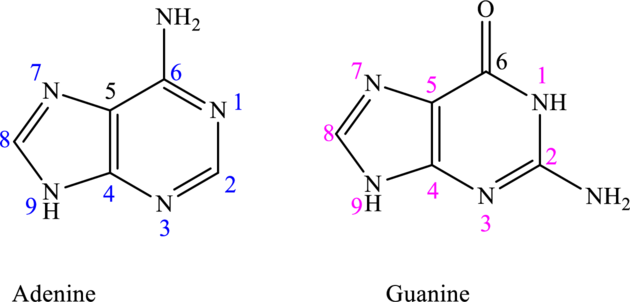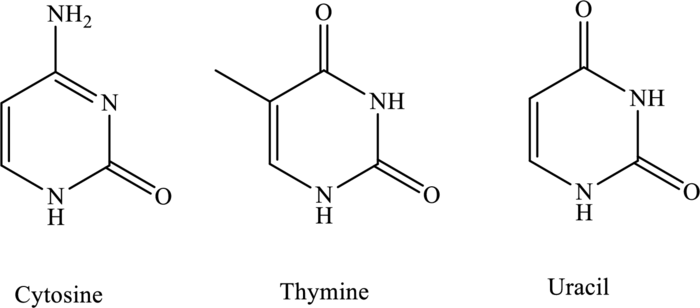
GEN ORG/BIO CHEM LL W/CONNECT ACCESS
10th Edition
ISBN: 9781265424701
Author: Denniston
Publisher: MCG
expand_more
expand_more
format_list_bulleted
Concept explainers
Question
Chapter 20, Problem 20.23QP
Interpretation Introduction
Interpretation:
The adenine-thymine base pair has to be drawn. Also, the hydrogen bonds that link adenine-thymine base pair have to be indicated.
Concept Introduction:
There are two kinds of purines found in

There are three kinds of pyrimidines such as cytosine, thymine, and uracil.

Within the double-helical structures, these purine and pyrimidines form hydrogen bonds so as to stables the helical conformation.
Expert Solution & Answer
Want to see the full answer?
Check out a sample textbook solution
Students have asked these similar questions
Please help me solve this reaction.
Indicate the products obtained by mixing 2,2-dimethylpropanal with acetaldehyde and sodium ethoxide in ethanol.
Synthesize 2-Ethyl-3-methyloxirane from dimethyl(propyl)sulfonium iodide using the necessary organic or inorganic reagents. Draw the structures of the compounds.
Chapter 20 Solutions
GEN ORG/BIO CHEM LL W/CONNECT ACCESS
Ch. 20.1 - Prob. 20.1QCh. 20.1 - Prob. 20.2QCh. 20.4 - Prob. 20.3QCh. 20.4 - Prob. 20.4QCh. 20.5 - Prob. 20.5QCh. 20.5 - Prob. 20.6QCh. 20.6 - How are codons related to anticodons?
Ch. 20.6 - Prob. 20.8QCh. 20.6 - Prob. 20.9QCh. 20.6 - Prob. 20.10Q
Ch. 20.7 - Prob. 20.11QCh. 20.7 - The sequence of a gene on the mRNA is normally...Ch. 20 - Prob. 20.13QPCh. 20 - Prob. 20.14QPCh. 20 - Prob. 20.15QPCh. 20 - Prob. 20.16QPCh. 20 - Prob. 20.17QPCh. 20 - Prob. 20.18QPCh. 20 - Prob. 20.19QPCh. 20 - Prob. 20.20QPCh. 20 - Prob. 20.21QPCh. 20 - Prob. 20.22QPCh. 20 - Prob. 20.23QPCh. 20 - Prob. 20.24QPCh. 20 - Prob. 20.25QPCh. 20 - Prob. 20.26QPCh. 20 - Prob. 20.27QPCh. 20 - Prob. 20.28QPCh. 20 - Prob. 20.29QPCh. 20 - Prob. 20.30QPCh. 20 - Prob. 20.31QPCh. 20 - Prob. 20.32QPCh. 20 - Prob. 20.33QPCh. 20 - Prob. 20.34QPCh. 20 - Prob. 20.35QPCh. 20 - Prob. 20.36QPCh. 20 - What is the function of the enzyme helicase?
Ch. 20 - Prob. 20.38QPCh. 20 - Prob. 20.39QPCh. 20 - Prob. 20.40QPCh. 20 - Prob. 20.41QPCh. 20 - Prob. 20.42QPCh. 20 - Prob. 20.43QPCh. 20 - Prob. 20.44QPCh. 20 - Prob. 20.45QPCh. 20 - Prob. 20.46QPCh. 20 - Prob. 20.47QPCh. 20 - Prob. 20.48QPCh. 20 - Prob. 20.49QPCh. 20 - Prob. 20.50QPCh. 20 - Prob. 20.51QPCh. 20 - Prob. 20.52QPCh. 20 - Prob. 20.53QPCh. 20 - Prob. 20.54QPCh. 20 - Prob. 20.55QPCh. 20 - Prob. 20.56QPCh. 20 - Prob. 20.57QPCh. 20 - Prob. 20.58QPCh. 20 - Prob. 20.59QPCh. 20 - What happens to the reading frame of a gene if a...Ch. 20 - Prob. 20.61QPCh. 20 - Prob. 20.62QPCh. 20 - Prob. 20.63QPCh. 20 - Prob. 20.64QPCh. 20 - Prob. 20.65QPCh. 20 - Prob. 20.66QPCh. 20 - Prob. 20.67QPCh. 20 - Prob. 20.68QPCh. 20 - Prob. 20.69QPCh. 20 - Prob. 20.70QPCh. 20 - Prob. 20.71QPCh. 20 - Prob. 20.72QPCh. 20 - Prob. 20.73QPCh. 20 - Prob. 20.74QPCh. 20 - Prob. 20.75QPCh. 20 - Prob. 20.76QPCh. 20 - Prob. 20.77QPCh. 20 - Prob. 20.78QPCh. 20 - Prob. 20.79QPCh. 20 - Prob. 20.80QPCh. 20 - Prob. 20.81QPCh. 20 - Prob. 20.82QPCh. 20 - Prob. 20.83QPCh. 20 - Prob. 20.84QPCh. 20 - Prob. 20.85QPCh. 20 - Prob. 20.86QPCh. 20 - Prob. 20.87QPCh. 20 - Prob. 20.88QPCh. 20 - Prob. 20.89QPCh. 20 - Prob. 20.90QPCh. 20 - Prob. 20.91QPCh. 20 - Prob. 20.92QPCh. 20 - Prob. 20.93QPCh. 20 - Prob. 20.94QPCh. 20 - Prob. 20.95QPCh. 20 - Prob. 20.96QPCh. 20 - Prob. 1MCPCh. 20 - Prob. 2MCPCh. 20 - Consider the Chapter Map, and explain the...Ch. 20 - Prob. 4MCPCh. 20 - Prob. 5MCPCh. 20 - Prob. 6MCPCh. 20 - Prob. 7MCPCh. 20 - Prob. 8MCPCh. 20 - Prob. 10MCP
Knowledge Booster
Learn more about
Need a deep-dive on the concept behind this application? Look no further. Learn more about this topic, chemistry and related others by exploring similar questions and additional content below.Similar questions
- Synthesize 2-Hydroxy-2-phenylacetonitrile from phenylmethanol using the necessary organic or inorganic reagents. Draw the structures of the compounds.arrow_forwardSynthesize N-Methylcyclohexylamine from cyclohexanol using the necessary organic or inorganic reagents. Draw the structures of the compounds.arrow_forwardSynthesize N-Methylcyclohexylamine from cyclohexanol using the necessary organic or inorganic reagents. Draw the structures of the compounds.arrow_forward
- If possible, please provide the formula of the compound 3,3-dimethylbut-2-enal.arrow_forwardSynthesize 1,4-dibromobenzene from acetanilide (N-phenylacetamide) using the necessary organic or inorganic reagents. Draw the structures of the compounds.arrow_forwardIndicate the products obtained by mixing (3-oxo-3-phenylpropyl)triphenylphosphonium bromide with sodium hydride.arrow_forward
- We mix N-ethyl-2-hexanamine with excess methyl iodide and followed by heating with aqueous Ag2O. Indicate the major products obtained.arrow_forwardIndicate the products obtained by mixing acetophenone with iodine and NaOH.arrow_forwardIndicate the products obtained by mixing 2-Propanone and ethyllithium and performing a subsequent acid hydrolysis.arrow_forward
- Indicate the products obtained if (E)-2-butenal and 3-oxo-butanenitrile are mixed with sodium ethoxide in ethanol.arrow_forwardQuestion 3 (4 points), Draw a full arrow-pushing mechanism for the following reaction Please draw all structures clearly. Note that this intramolecular cyclization is analogous to the mechanism for halohydrin formation. COH Br + HBr Brarrow_forwardIndicate the products obtained if 2,2-dimethylpropanal and acetaldehyde are mixed with sodium ethoxide in ethanol.arrow_forward
arrow_back_ios
SEE MORE QUESTIONS
arrow_forward_ios
Recommended textbooks for you
 ChemistryChemistryISBN:9781305957404Author:Steven S. Zumdahl, Susan A. Zumdahl, Donald J. DeCostePublisher:Cengage Learning
ChemistryChemistryISBN:9781305957404Author:Steven S. Zumdahl, Susan A. Zumdahl, Donald J. DeCostePublisher:Cengage Learning ChemistryChemistryISBN:9781259911156Author:Raymond Chang Dr., Jason Overby ProfessorPublisher:McGraw-Hill Education
ChemistryChemistryISBN:9781259911156Author:Raymond Chang Dr., Jason Overby ProfessorPublisher:McGraw-Hill Education Principles of Instrumental AnalysisChemistryISBN:9781305577213Author:Douglas A. Skoog, F. James Holler, Stanley R. CrouchPublisher:Cengage Learning
Principles of Instrumental AnalysisChemistryISBN:9781305577213Author:Douglas A. Skoog, F. James Holler, Stanley R. CrouchPublisher:Cengage Learning Organic ChemistryChemistryISBN:9780078021558Author:Janice Gorzynski Smith Dr.Publisher:McGraw-Hill Education
Organic ChemistryChemistryISBN:9780078021558Author:Janice Gorzynski Smith Dr.Publisher:McGraw-Hill Education Chemistry: Principles and ReactionsChemistryISBN:9781305079373Author:William L. Masterton, Cecile N. HurleyPublisher:Cengage Learning
Chemistry: Principles and ReactionsChemistryISBN:9781305079373Author:William L. Masterton, Cecile N. HurleyPublisher:Cengage Learning Elementary Principles of Chemical Processes, Bind...ChemistryISBN:9781118431221Author:Richard M. Felder, Ronald W. Rousseau, Lisa G. BullardPublisher:WILEY
Elementary Principles of Chemical Processes, Bind...ChemistryISBN:9781118431221Author:Richard M. Felder, Ronald W. Rousseau, Lisa G. BullardPublisher:WILEY

Chemistry
Chemistry
ISBN:9781305957404
Author:Steven S. Zumdahl, Susan A. Zumdahl, Donald J. DeCoste
Publisher:Cengage Learning

Chemistry
Chemistry
ISBN:9781259911156
Author:Raymond Chang Dr., Jason Overby Professor
Publisher:McGraw-Hill Education

Principles of Instrumental Analysis
Chemistry
ISBN:9781305577213
Author:Douglas A. Skoog, F. James Holler, Stanley R. Crouch
Publisher:Cengage Learning

Organic Chemistry
Chemistry
ISBN:9780078021558
Author:Janice Gorzynski Smith Dr.
Publisher:McGraw-Hill Education

Chemistry: Principles and Reactions
Chemistry
ISBN:9781305079373
Author:William L. Masterton, Cecile N. Hurley
Publisher:Cengage Learning

Elementary Principles of Chemical Processes, Bind...
Chemistry
ISBN:9781118431221
Author:Richard M. Felder, Ronald W. Rousseau, Lisa G. Bullard
Publisher:WILEY
Nucleic acids - DNA and RNA structure; Author: MEDSimplified;https://www.youtube.com/watch?v=0lZRAShqft0;License: Standard YouTube License, CC-BY